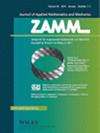Entropy generation analysis of CNT‐based nanofluid flows induced by a moving plate
IF 3.2
4区 工程技术
Q1 MATHEMATICS, APPLIED
Zamm-zeitschrift Fur Angewandte Mathematik Und Mechanik
Pub Date : 2023-08-27
DOI:10.1002/zamm.202200555
引用次数: 0
Abstract
Carbon nanotubes have garnered considerable interest from academia and industry due to their unique properties and potential applications. This study examines fluid flow induced by a plate moving at a constant velocity towards/receding from normal stagnation point flow. The plate's surface is immersed with ethylene glycol and two types of carbon nanotubes: single‐walled and multi‐walled. The Reynolds number, proportional to the plate's velocity, governs the flow. Thermal transport analysis includes Ohmic heating, heat source/sink effects for constant wall temperature and prescribed surface temperature, and entropy generation analysis. Similarity ansatz is used to obtain non‐dimensional ordinary differential equations, and numerical and asymptotic solutions are computed using MATLAB's bvp4c routine (finite difference‐based approach). By varying the relevant parameters, the study interprets the behavior of entropy generation, Bejan number, skin frictions, Nusselt number, flow, and energy profiles. The numerical solutions are observed to match their asymptotic behaviors within an intermediate range of small and large Reynolds numbers for the wall stress parameter. The magnetic parameter produces a resistive force that reduces fluid flow but enhances the system's energy. Moreover, understanding the flow and heat transfer characteristics of CNT‐based nanofluids induced by a moving plate can provide insights into the design and optimization of thermal systems, including efficient heat exchangers used in power generation, chemical, and petrochemical industries.移动板诱导碳纳米管纳米流体流动的熵生成分析
碳纳米管由于其独特的性能和潜在的应用前景,引起了学术界和工业界的极大兴趣。本研究考察了一个板块以恒定速度向正常驻点流动移动或从正常驻点流动后退所引起的流体流动。板的表面浸有乙二醇和两种类型的碳纳米管:单壁和多壁。雷诺数与板的速度成正比,控制着流动。热传递分析包括欧姆加热,恒定壁温和规定表面温度下的热源/汇效应,以及熵生成分析。相似性分析用于获得无维常微分方程,并使用MATLAB的bvp4c例程(基于有限差分的方法)计算数值解和渐近解。通过改变相关参数,该研究解释了熵生成、贝让数、表面摩擦、努塞尔数、流量和能量分布的行为。数值解在壁面应力参数的小雷诺数和大雷诺数中间范围内的渐近行为是一致的。磁性参数产生的阻力减少了流体流动,但提高了系统的能量。此外,了解由移动板引起的基于碳纳米管的纳米流体的流动和传热特性可以为热系统的设计和优化提供见解,包括用于发电,化工和石化工业的高效热交换器。
本文章由计算机程序翻译,如有差异,请以英文原文为准。
求助全文
约1分钟内获得全文
求助全文
来源期刊
CiteScore
3.30
自引率
8.70%
发文量
199
审稿时长
3.0 months
期刊介绍:
ZAMM is one of the oldest journals in the field of applied mathematics and mechanics and is read by scientists all over the world. The aim and scope of ZAMM is the publication of new results and review articles and information on applied mathematics (mainly numerical mathematics and various applications of analysis, in particular numerical aspects of differential and integral equations), on the entire field of theoretical and applied mechanics (solid mechanics, fluid mechanics, thermodynamics). ZAMM is also open to essential contributions on mathematics in industrial applications.

 求助内容:
求助内容: 应助结果提醒方式:
应助结果提醒方式:


